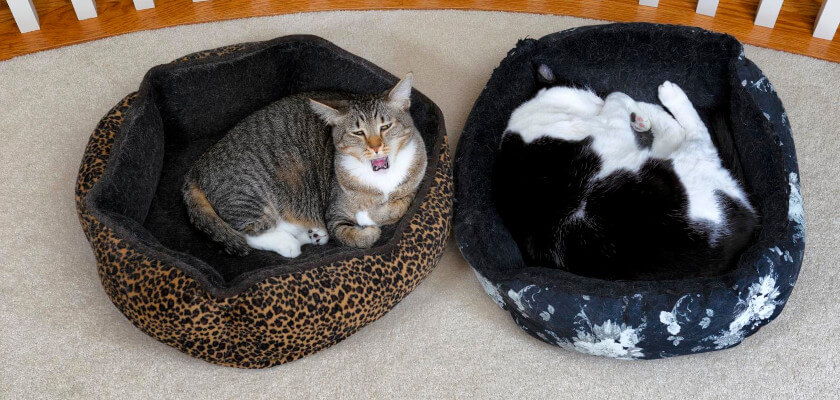Two cats in an apartment is a dream for some, and a real challenge for others. Many caregivers assume (otherwise often right) that a cat feels lonely during its long absence at home. The second cat in the house, whether taken on impulse or out of sheer goodness of heart, cannot be treated worse. However, it is worth remembering that the resident’s welfare should always be the priority. How to successfully combine two cats with each other and take into account the needs of each of them? Read on to find out!
Two cats or one – that is the question!
Is it worth taking another cat home? This is a question most carers ask themselves. If you have adequate housing and resources, then the answer to this question seems simple.
Meanwhile, there is one more very important factor that determines the answer to this important question. He’s a resident, that is, your first feline friend. Why do you need to remember about it?
The structure of the feline clusters and the other cat in the house
Cats, unlike dogs, are not genetically determined to live in a herd. At the same time, it is also not true that cats are loners. The truth lies in the middle. Free-living cats most often live in colonies consisting of a few to a dozen individuals, mostly females with young. If you are considering a second cat in the house, learn about the natural behavior of these animals in larger groups.
What do cats do together and when do they need solitude?
Observations of such gatherings have shown that cats do many activities together – mainly they raise their young together. They hunt and eat individually. It is therefore worth thinking of cat gatherings more as colonies than as hierarchical flocks. Several individuals live in harmony in one territory. Deep bonds do not always develop between individuals. You could say that these animals are just roommates who share an apartment without getting in each other’s way.
Theoretically, there are no obstacles to bringing a new cat into the house. However, you need to take care of the socialization process and make sure that there are no contraindications for it.
When is a second cat in the house not a good idea?
Serious contraindications for taking a second cat home include:
- chronic health problems in your cat;
- your cat is very sensitive and stressed by even slight changes in the environment;
- your cat has behavioral problems (overestimation is not a way to solve them, as a second cat in the house can make things worse).
The second cat in the house – how to introduce it correctly?
The second cat in the house – time is your friend
Very often you can meet with comments from people who are despairing two days after bringing a new cat home. The animals hiss at each other and growl. However, it is worth being aware that three days is definitely too little time to check whether the cats will accept each other. If a second cat appears in the house, the minimum adaptation time is around four weeks.
Two cats in the house – socialization with isolation
At first, the resident and the new cat should not come into contact with each other at all. Imagine that someone suddenly introduces a complete stranger into your bedroom. The chance that you will want to get into a close relationship with her right away is quite remote. It is similar in cats. You bring a foreign individual into your pet’s territory. To minimize the risk of conflicts, you need to implement socialization with isolation.
Isolation, i.e. the second cat in the house and its introduction
In order for your pet to get used to the other cat in the house, pets must be separated from each other at first.
- Plan a separate room for the new member of the household. It can even be a small bathroom.
- Do not show the resident the transporter with the intruder, do not let the cats smell each other. A violent and unpleasant reaction can create a bad feeling that is hard to blur later.
Exchange the smells of the first and second cats at home
After some time, you can move on to the exchange of fragrances.
- In the beginning, carry it on your hands while stroking one cat first, then the other.
- Then you can move blankets or bedding between rooms.
- It will also be a good idea to show the resident the transporter in which the new cat has arrived.
Eating together
Eating together is a very important stage of socialization with isolation. In order for both cats in the house to accept each other, he will place the bowls on either side of the door and let them eat while hearing each other and smelling each other’s smell. In this way, you will associate their joint presence with the good stimulus of food.
Stressed cats may refuse to eat. If they are reluctant to eat a meal close to each other, this is a clear signal that you still have to wait. When they feel calm while eating, you can gradually open the door. The last step is to open them wide.
The multiplication of resources, i.e. the second cat in the house must have a place
In order for cats to live freely in one territory, you need to increase the number of resources. It is mainly about:
- cups;
- drapakach;
- bedding;
- blankets;
- kuwetach;
- hiding places.
The more of them in the apartment, the lower the chance of conflicts and the lower the stress level. The second cat in the house cannot have worse conditions than the resident, so take care of his comfort.
Two cats in the house – problems connecting
Sometimes there are problems when connecting a new cat to a resident cat. It is often the fault of the keepers who put two individuals into direct contact too quickly. It is also often related to the character of cats, their past and experiences.
Sometimes, however, animals do not like each other. This does not happen often, but it cannot be ruled out. Then you need to work with a behaviorist who will help encourage the animals to live together in neutral relationships.
The second cat in the house – how do cats perceive closeness?
When a new cat arrives at your home, you surely want to get along with the resident. Many owners, however, feel disappointed because cats, despite seemingly good relations, do not spend time together. They don’t wash each other’s fur, they don’t hug each other, and sometimes they snort at each other. The guardian then wonders why his cats do not like each other. Meanwhile, this is not true at all.
Why do the other cat in the house and the resident keep their distance?
You have to understand that cats understand closeness quite differently from humans. This applies to both intraspecific relationships and interactions with humans. For people, closeness and friendship comes down to spending time next to each other, and often to touching. Cats see it quite differently. Their communication takes place primarily at the level of body language. It is only natural for them to communicate remotely. If the other cat in the house keeps some distance, don’t worry about it!
Two cats in an apartment do not have to make love
You must remember that your cats do not have to feel passionate about each other. On a daily basis, they can spend time in completely different parts of the house, and at the same time understand each other well and tolerate their presence.
Whether the other cat in the house can get along with the resident?
The areas where free-living cats live together are usually quite spacious. A flat in a block of flats, and even a house with a secured garden, are often much smaller than them. While one cat is resting on the living room windowsill, the other cat can use the scratching post in the kitchen. They understand it as spending time together.
There is, of course, the possibility that a strong bond will develop between the two cats. Then they are more likely to spend time together. They hug each other and wash each other’s fur. This happens, however, much less frequently than relations that are simply neutral.
How do you know if your cat’s relationship is bad?
The second cat in the house and the resident are not that affectionate though, and are you wondering how to tell if there is something wrong between them? First of all, it is worth noting that hissing at each other can happen even in cats that live on good terms with each other. However, it is worth presenting a few worrying situations.
- If one of the cats often hides, does not leave their hiding places, and additionally loses their appetite, it is possible that they feel hunted by the other one.
- Another cause for concern are greeds, i.e. situations where there are open fights between cats. Cat fights are usually quite spectacular, but serious wounds occur in very extreme situations. So if cats hurt themselves, it is imperative to act.
The best solution in such difficult situations is to consult a behaviorist. On your own, you can unconsciously aggravate the problem.
The second cat in the house – summary
Contrary to popular belief, cats are not loners. Although territorial, they are willing to share space with other individuals with whom they get along well. If your resident is a healthy cat that has successfully undergone primary socialization (being allowed up to 12 weeks of age to be with his mother and siblings), the appearance of a second cat at home should not be problematic. However, a lot depends on your actions.
Socialization with isolation is a process that can take a while. However, it is worth preparing all its stages, because in this way you will minimize the risk of alienation from each other at the very beginning of the relationship. Gradual accustoming to the smell of a new member of the household will greatly facilitate the process of its acceptance for the resident. In case of problems with the other cat at home and its acceptance by the current pet, the best solution is to consult a cat behaviorist.


